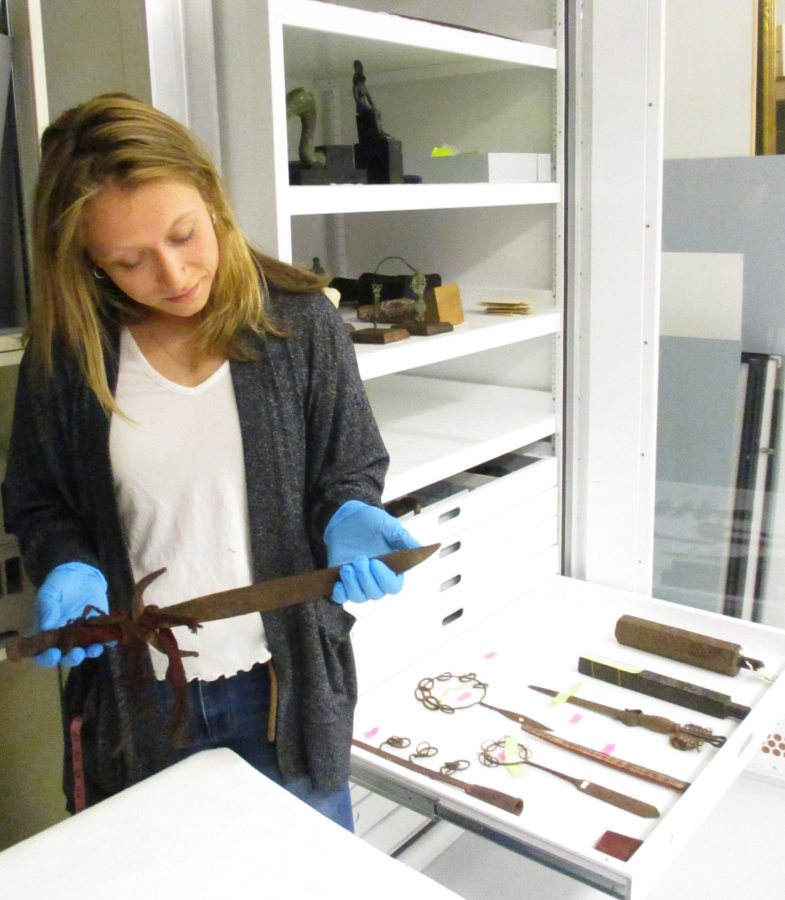Looking Beyond the Surface

Shelbie McCormack examines a Vietnamese ceremonial dagger while cataloging objects for Bates College Museum of Art
The pieces that come through the Bates College Museum of Art are diverse to say the least. As a Collections Management Intern, I have seen a variety of pieces that were acquired through donations, as well as purchases from the past few years. Over the course of the semester, I have worked with the refugee prints of Peter Turnley, an abundance of flower prints from Joyce Tenneson, and the dream-like, coastal prints of Jeffrey Becton. I have enjoyed accessioning these prints for their subject matter has varied immensely from artist to artist.
The collection that my fellow intern, Hawley Moore, and I most recently cataloged has been of greatest interest to me. In 2014, the Museum received a gift from Mark S. Rapoport. MD, at 54 Traditions Gallery based in Hanoi, Vietnam. Following this transaction, the Museum purchased additional pieces to add to their Vietnamese collection. These pieces included paintings depicting the “Ancestors of the Shaman,” Shamanic bridge scroll paintings, paper crowns, forehead masks, as well as ceremonial power rattles, printing blocks, and a ceremonial sword. Due to their age, these pieces have required a different level of care and attention. The paintings for example, are fraying, ripped, faded, and even flaking. The metal objects have a thick layer of rust coating them; they have also begun to chip. More fragile and older than the prints, these three-dimensional objects have been more interesting for me to observe, and later catalogue. Able to look at these objects from multiple angles and perspectives, I immediately begin thinking about the journey that these objects have taken to reach their current place in my hands or on my work station. Although conservation is a concern, you can learn so much about a piece’s history and condition by examining it closely. Every flaw has a story just as every paintbrush stroke or photograph would. My favorite piece in the collection is a ceremonial sword that has detailing on the hilt. Part of this detailing includes pieces of cloth that are tied and wrapped around the grip. Completely discolored and tattered, the original color of this cloth material is unidentifiable. This one detail, however, could be pertinent to understanding the history of the sword, its symbolic nature, and overall use in society. The color red, for example, is associated with strength and love, green with nature, yellow with sunshine and contentment, and purple is associated with royalty. These small details have the potential to completely alter a story or create one previously unknown to the viewer. This idea truly fascinates me and entices me to ask questions.
Although the Museum was given a small guide to the items they received from the Gallery, I think there is a lot of room to better understand the intention behind each of these pieces. Why, for example, was the ceremonial sword used? Is there a previous case of the sword being used for functional purposes rather than symbolic? How old is the tradition? Why was it important for the sword to be kept in a secure place, ending up in a museum? These are some of the questions that I would love the opportunity to explore further. I can only imagine what other objects and histories are stored away in the Bates College Museum of Art collection and their archives.
Shelbie McCormack, Winter ’19
Art & Visual Culture and Classical & Medieval Studies Major